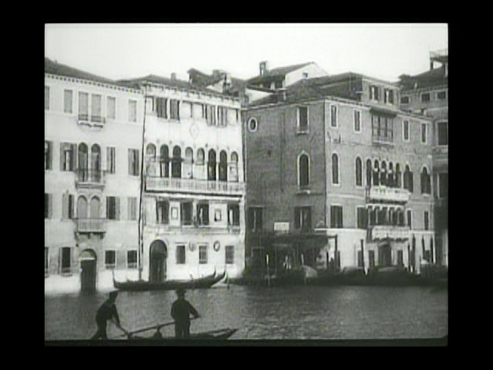
Reviews of silent film releases on home video.
Copyright © 1999-2025 by Carl Bennett
and the Silent Era Company.
All Rights Reserved. |
|
The
Lumière Brothers’
First Films
(1895-1897)
|
Contents: L’Arroseur arrosé (1895), Debarquement du congrès de photographes à Lyon (1895), Démolition d’un mur (1895), Partie d'écarté (1895), Place des Cordeliers (1895), Le repas de bébé (1895), La sortie des ouvriers de l'usine Lumière (1895) [first version], La sortie des ouvriers de l'usine Lumière (1895) [second version], La sortie des ouvriers de l'usine Lumière (1895) [third version], Arrivée d’un train à Perrache (1896), L’arrivée d’un train en Gare de la Ciotat (1896), Panorama de l’arrivée en gare de Perrache pris du train (1896), Quai de l’Archevêché (1896), Water toboggan (montagnes russes sur l'eau) (1896), Bataille d’oreillers (no. 2) (1898), Fête de Paris 1899: Concours d’automobiles fleuries (1899), La petite fille et son chat (1899), Bicycliste (1896), Concours de boules (189?), Défilé de voitures de bébés à la pouponnière de Paris (189?), Enfants jouant aux billes (1896), Le goûter de bébés (189?), Place du Pont (1897), Premiers pas de bébé (1896), Exposition Universalle de 1900: Vue prise d’une plate-forme mobile II (1900) and more than 50 other Lumière films.
Auguste and Louis Lumière were the successful inventors of projected motion pictures. Since 1895, the Lumière brothers, and later their traveling cinematographers, created a series of motion pictures that were intended for projection for public audiences. The films were largely comprised of actuality documentaries. Some were comedies. Most of the films were 17 metres in length and about 50 seconds long. Through accidental genius or deliberate craft, the Lumière films have proven to be of high quality and value. The films are fascinating historical documents. They are valuable documentaries of fashions and activities of the late 1890s. They are also, in some instances, examples of high art.
— Carl Bennett
|

Estimates have approximately 1500 of the Lumière films surviving this past century. The Institut Lumière of Lyon, France, is dedicated to the preservation of the history and films of the Lumières, and selected more than 80 of the surviving films for presentation at a special event on 19 March 1995, to commemorate the cinematography of the first Lumière film, Sortie d’usine [Leaving the Factory], on 19 March 1895. The program of films was gathered together into a home video collection in 1996 for release on laserdisc and videotape.
The program features high quality video transfers from original Lumière negatives, with some from original prints, in windowboxed format. The DVD utilizes the same transfer as the laserdisc and videotape editions from Kino. For the DVD edition, and for the first time, three stereo audio options are available. A user can select commentary on the films in English by filmmaker Bertrand Tavernier with music score, commentary in French by Institut director Thierry Fremaux, or an isolated piano score by Stuart Oderman.
Tavernier’s commentary is in turns informative, authoratative and amusing. But there are many claims from Tavernier, some tongue-in-cheek, that the Lumière made the first documentary, home movie, comedy, commercial film, suspense film, newsreel, soccer film, the first film recording the act of a motion picture being taken, etc., that keep us smirking.
Most of the films are in very good condition. Print damage is apparent in some of the films, but it is rarely distracting. Most of the films show very-good greyscale ranges, with some of the films being on the contrasty side (it is likely those films were transferred from prints rather than negatives and from films shot in bright, direct light).
All three versions of Lumières’ first film, Leaving the Factory, are available on the disc. The film was likely reshot to replace worn negatives or to attempt to improve previous editions. At any rate, the Institut has preserved and identified the three versions, including the original film. The film Demolishing a Wall is presented both forward and backwards on the disc. Early Lumière projectionists accidently discovered that the felling and dissection of a wall at the Lumière factory, run backwards, was a hit with audiences unused to the visual phenomenon.
The film Place du Pont, shot in Lyon, features an early tracking shot. The camera first tracks forward, by unknown means, into the street scene and then slowly backward. From the Lumière catalog number (1126), the film appears to have been shot later than 1896 or 1897. Of interest, on viewing the film it appears the tracking movement was planned and deliberate, since it wasn’t the result of the camera being placed on a moving vehicle or vessel, which was common in the films of the late 1890s.
A seeming rarity among Lumière films, Pillow Fight is a comedy shot on an indoor set. As is noted in Tavernier’s commentary, Lumière comedies were not that rare despite the modern impression that the Lumière films were mostly actualities. Also on the disc is the beautiful film Mont Blanc, the Alps, a street view. With its wonderful composition, greytones, and details, if the shot were taken today with modern filmstocks and equipment it wouldn’t look as beautiful.
We like the section, The Lumière Path, for its few striking and beautiful films. And late in the disc is a fine example of what can be considered to be an Edison film form combined with what could be considered a Pathé form. Serpentine Dance, shows a solitary dancer against a black background in a creatively hand-colored film.
Although this DVD program is short in length it is nevertheless a valuable and entertaining document of the Lumière films. The high quality of the film materials, the windowboxed video transfer, and Tavernier’s commentary make this disc a worthwhile addition to a silent film collection despite its relatively high cost.
|
This Region 0 NTSC DVD edition has been discontinued
and is . . .
|

|
|




































